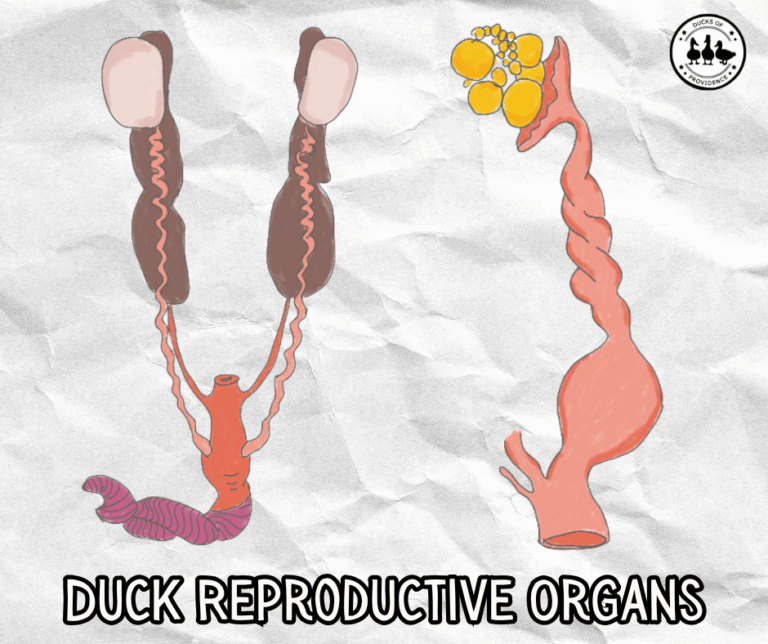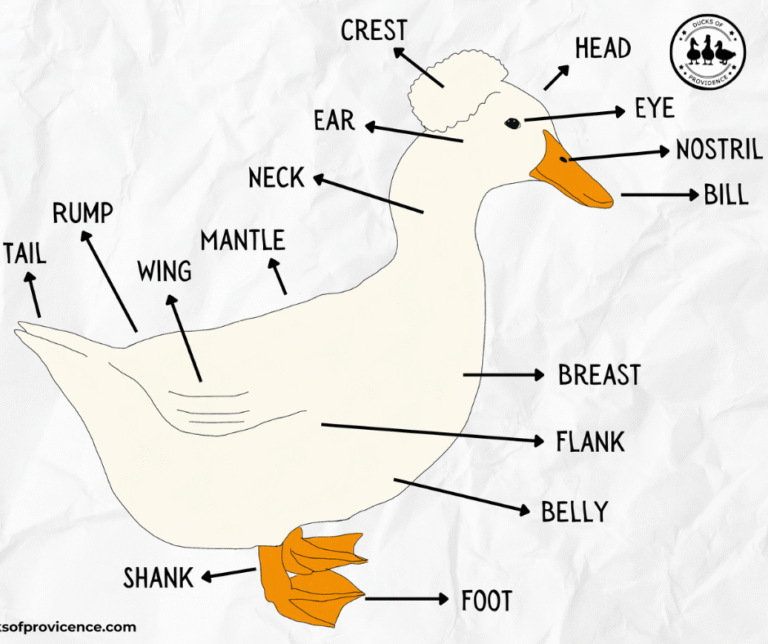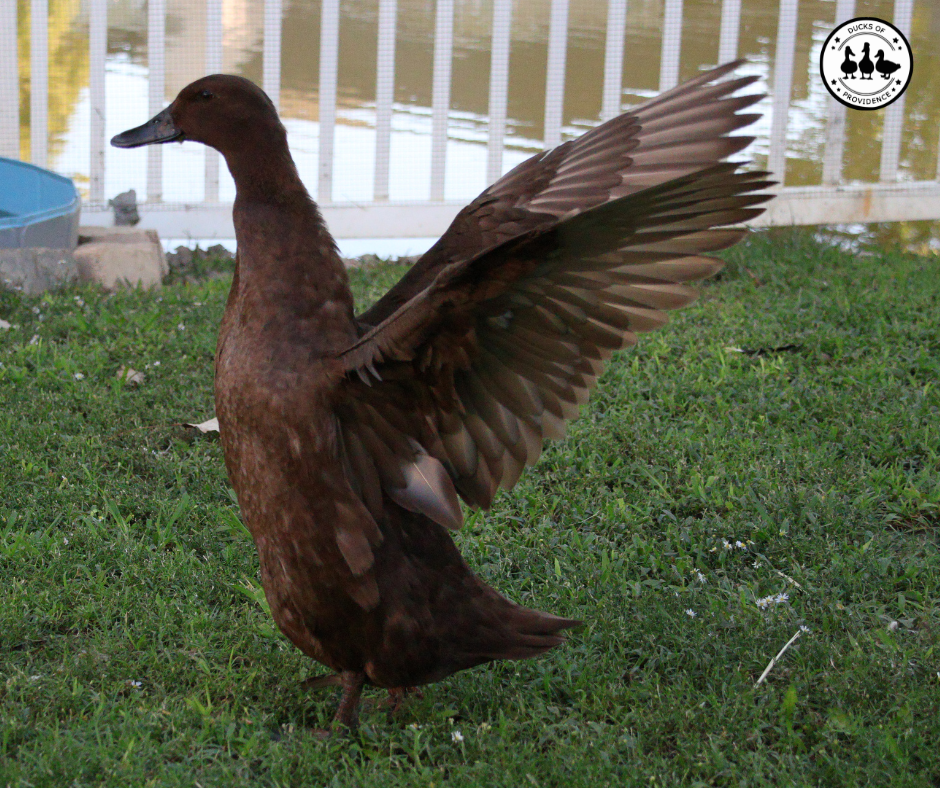
The Science Behind Duck Feathers: Anatomy, Function & Care
Diving into duck feather facts reveals a world of intricate design and purpose that keeps your feathered friends warm, dry, and colorful. From the soft underlayer of down to the sleek contour feathers that repel water, each plume plays a vital role in insulation, buoyancy, and even communication. In this post, we’ll explore the chemistry behind keratin, the physics of iridescent hues, and practical tips for keeping your ducks’ feathers healthy—so you can better understand, appreciate, and care for one of nature’s most remarkable adaptations.
Ducks of Providence is free, thanks to reader support! Ads and affiliate links help us cover costs—if you shop through our links, we may earn a small commission at no extra cost to you. Thanks for helping keep our content free and our ducks happy! 🦆 Learn more
Chemical Composition & Feather Structure
Feathers are built from a specialized form of protein—β-keratin—organized into a hierarchy of structures that together deliver strength, flexibility, and lightness.
β-Keratin Biochemistry
At their core, feathers consist predominantly of β-keratin, a fibrous protein richer in cysteine (and thus in disulfide bonds) than the α-keratin found in mammalian hair and nails. These covalent S–S linkages between cysteine residues lend feathers remarkable tensile strength and resistance to degradation. Within each feather fiber, keratin polypeptides align into β-pleated sheets; stacks of these sheets aggregate into microfibrils, which in turn bundle into macrofibrils. A matrix of non-keratin proteins and lipids fills the spaces between, contributing elasticity and helping feathers bend rather than snap under stress.
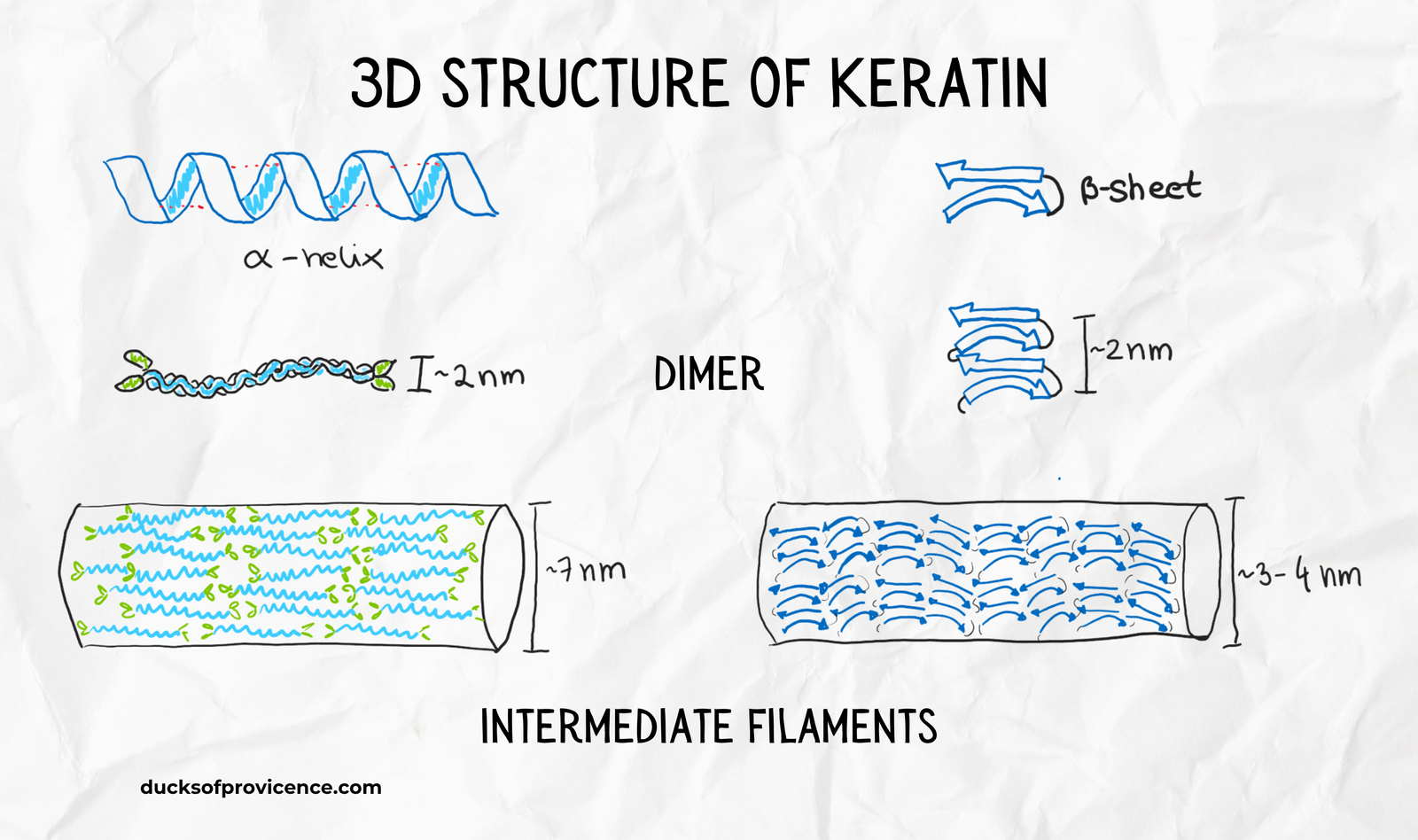
Amino Acid Composition
Keratin’s stability comes from high proportions of:
- Cysteine & Methionine: Sulfur-containing amino acids that form disulfide bonds.
- Glycine & Alanine: Small residues that allow tight packing of β-sheets.
- Serine & Threonine: Polar residues that aid in hydrogen bonding, stabilizing sheet stacking.
This precise mix yields a material that’s lightweight—densities around 1.3 g/cm³—but mechanically robust, with tensile strengths up to 1 GPa.
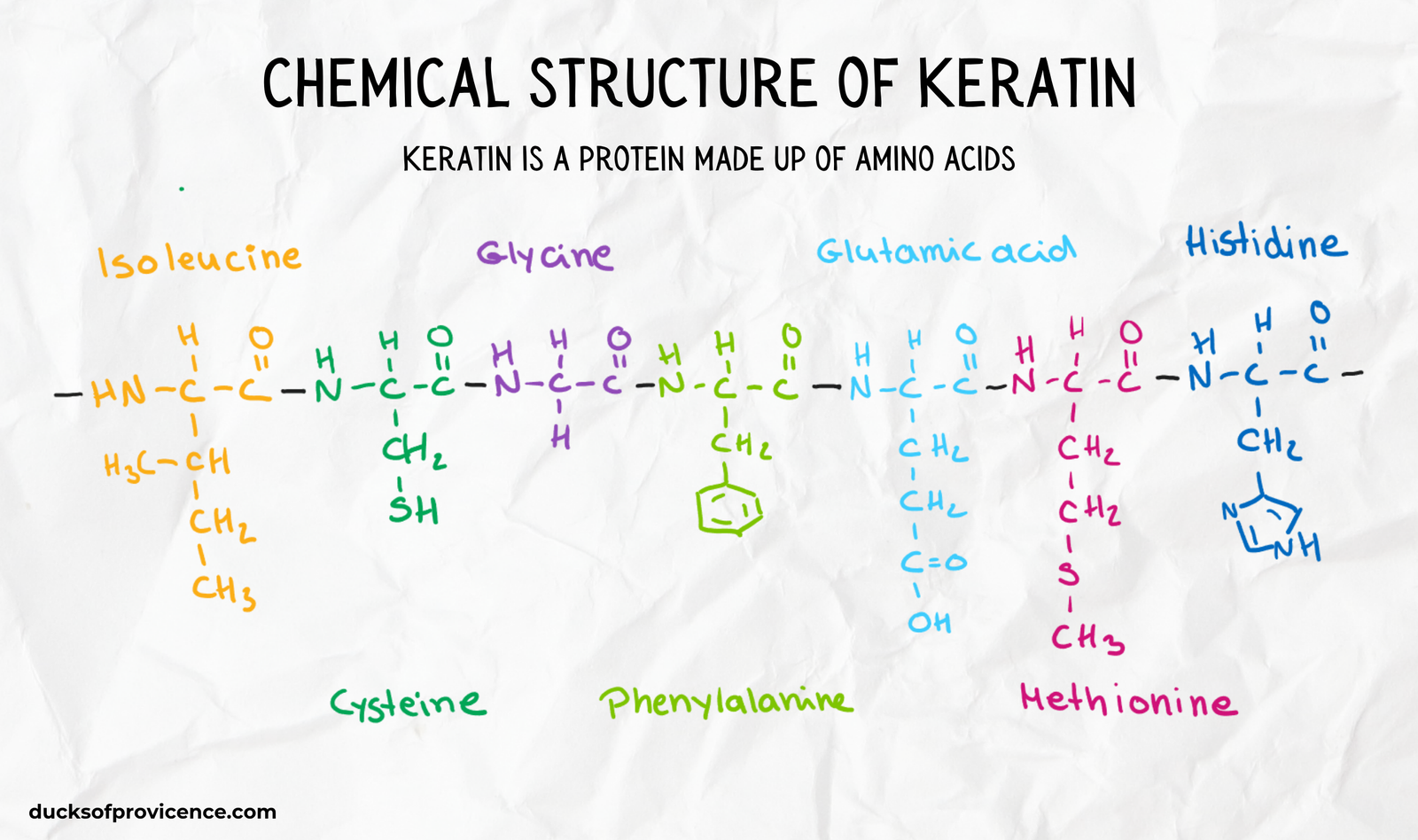
Feather Coloring: Chemistry & Physics
Feather color arises from two complementary systems—pigments that absorb and reflect specific wavelengths of light, and microscopic structures that manipulate light through physical processes. Together, these mechanisms give ducks their rich browns, fiery oranges, shimmering greens, and even ultraviolet highlights visible to their friends.
Pigment-Based Colors
Ducks manufacture or acquire pigment molecules and deposit them in their feathers:
- Melanins are synthesized in special cells called melanocytes. Eumelanin produces deep blacks and grays, while pheomelanin gives warm reds and rusty browns. Because melanin granules are embedded throughout the feather cortex, they provide long-lasting color and also increase feather toughness—helping guard against wear when ducks preen or brush through vegetation.
- Carotenoids are bright yellow, orange, or red pigments that ducks cannot make on their own. Instead, they derive these molecules from their diet—algae, aquatic plants, and small invertebrates. Once ingested, carotenoids circulate in the bloodstream and are selectively deposited in growing feathers. In many species, the richest concentrations appear at feather tips or along markings used in courtship displays.
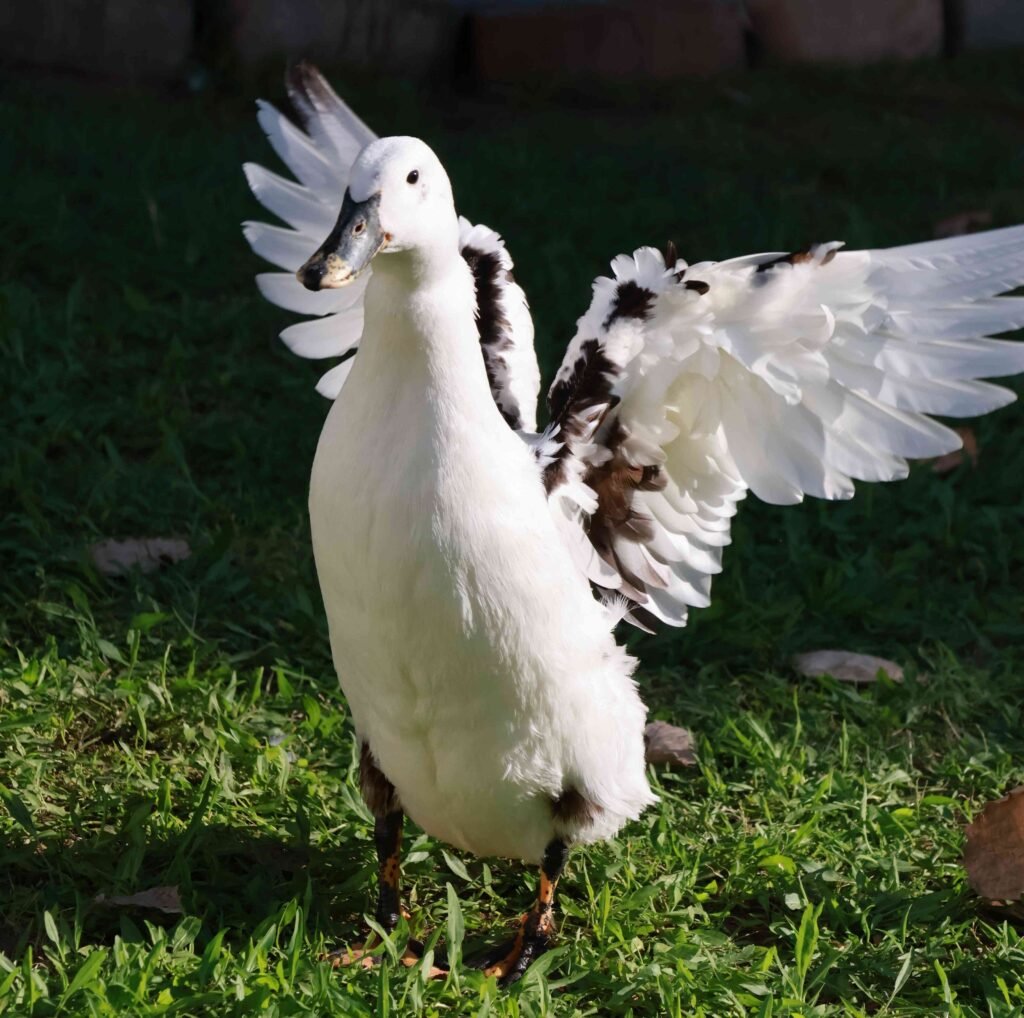
Because these pigments absorb specific wavelengths, the precise shade depends on the type and concentration of the pigment. A high density of eumelanin, for example, yields nearly jet-black feathers, while mixing pheomelanin and carotenoids can create rich chestnut tones. Dietary deficiencies—such as low carotenoid intake—often show up as dull, washed-out plumage, signaling poor health to potential mate ducks.
Fun Fact: Many dark-feathered breeds—like the jet-black Cayuga or the warm-tan Khaki Campbell—often develop white feathers as they age. This “progressive graying” happens because melanocyte activity (the cells that deposit dark melanin pigment) gradually declines over time. New feathers grow in with less pigment, so you’ll see isolated white quills at first, then larger patches, and sometimes an almost “salt-and-pepper” appearance in older birds. It’s a natural sign of maturity—no need to worry, it just shows your duck is gracefully growing up!
Structural Colors
Beyond pigment, ducks harness the physics of light itself. Within the feather cortex lie layers of keratin and tiny air pockets arranged at the nanometer scale. When light waves strike these multilayer stacks, some wavelengths interfere constructively, amplifying certain colors, while others cancel out. This is the same principle that makes soap bubbles or oil slicks shimmer.
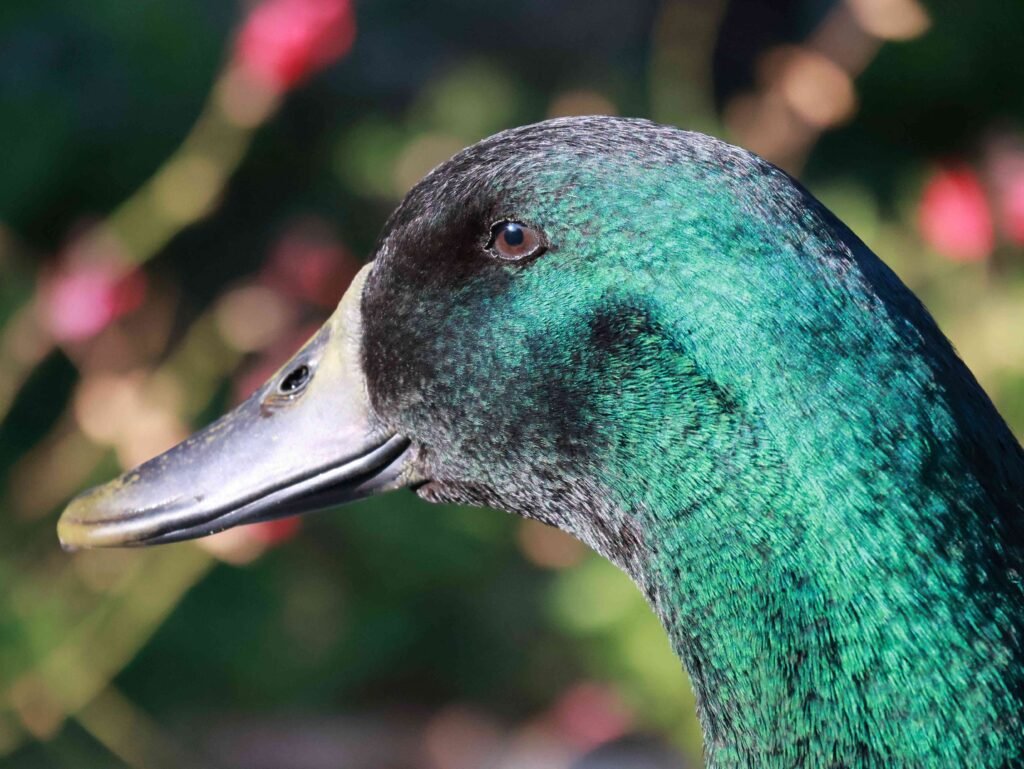
In mallard drakes, for example, the head feathers contain hundreds of parallel lamellae spaced just right to reflect vivid greens and blues. As the viewing angle changes, the distance between layers alters the constructive interference pattern, producing the signature iridescence that seems to dance in sunlight. Ducks may also exploit Tyndall scattering, where spongy medullary cells scatter shorter (blue) wavelengths more than longer ones, yielding soft blue or slate hues.
Iridescent Plumage
Many duck species display striking iridescent patches—most famously the Mallard drake’s green head or the teal’s speculum. This shimmering effect results from nanostructured layers within the barb cortex that selectively reflect and refract light. Because these layers are just a few hundred nanometers thick, slight changes in viewing angle or light intensity can dramatically shift perceived color. Iridescent plumage plays a key role in courtship displays, species recognition, and even signaling health and vitality—after all, only well-maintained feathers scatter light so brilliantly!
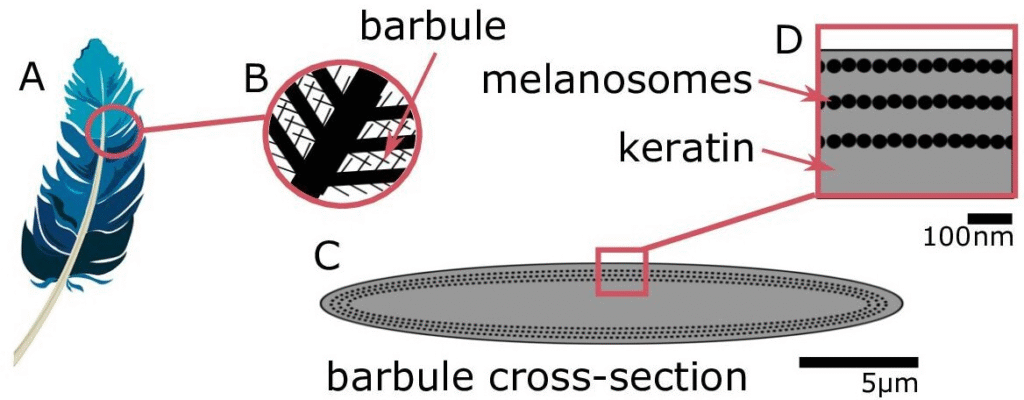
A vaned feather (A) consists of branching structures where the barbules (B) are the interlocking filaments. A cross-section of a barbule from an iridescent feather (C) reveals the intricate nanostructure responsible for the color, consisting of layers of melanosomes in keratin (D).
© 2016, Yuri B. Blue feather in (A) from Pixabay, licensed under the Pixabay License
Ultraviolet Highlights
Some ducks can even see—and display—patterns in the ultraviolet range. Specialized nanostructures reflect UV light that is invisible to humans but used by ducks for mate choice and social signaling, adding another hidden layer of visual communication.
By combining durable, diet-sensitive pigments with finely tuned nanostructures, ducks achieve a palette that functions both in camouflage and in dazzling courtship rituals. This dual system ensures that plumage remains vibrant, informative, and adaptive—an exquisite balance of chemistry and physics.
Feather Anatomy: From Quill to Barb
Feather morphology follows a branching design optimized for surface area, interlocking, and weight distribution.
- Calamus (Quill): The hollow, cylindrical base anchoring the feather into the skin’s follicle. Its rigidity comes from a thick cortical wall of keratin, protecting the feather’s blood supply during growth.
- Rachis (Shaft): Extending from the calamus, the rachis is the central support beam. Internally, it contains a foam-like medullary structure—numerous air pockets within the keratin matrix—that lightens the feather without sacrificing stiffness.
- Barbs: Along each side of the rachis, parallel barbs project, forming the feather vane. Each barb is a miniature version of the shaft, with its own cortex and medulla.
- Barbules & Hooklets: Branching off barbs are two rows of barbules:
- Inner (hook) barbules bear tiny hooks (hamuli).
- Outer (groove) barbules have grooves that catch the hooks.
- Cortex vs. Medulla: At the microscopic level, the cortex is a dense, keratinous shell giving each barb its shape, while the medulla’s porous core reduces weight and insulates.
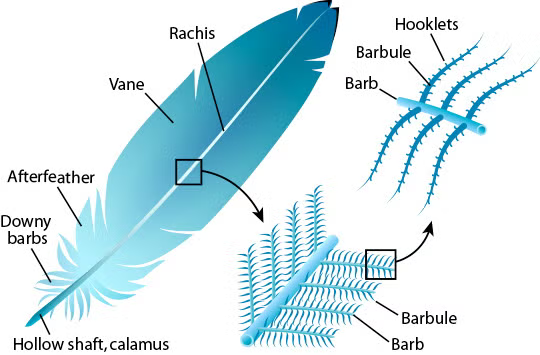
By understanding both the molecular makeup and the elegant, branching architecture of feathers, we see how ducks achieve a balance of strength, insulation, and buoyancy—key to their survival in air and water.
Types of Duck Feathers
Ducks boast an impressive variety of feather types, each perfectly adapted to a specific role—from soft down that traps warmth and keeps them cozy in icy waters, to sleek contour feathers that shed rain and streamline their bodies, and even specialized flight and sensory plumes that power their soaring and fine-tune their feather alignment. Together, these diverse feathers form a marvelously engineered coat that supports everything ducks do—swimming, flying, and communicating.
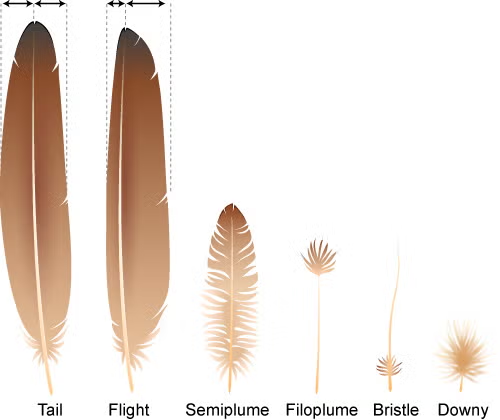
Down Feathers
Nestled closest to the skin, down feathers form the core insulating layer. Their delicate, curly barbs lack the hook-and-groove system of contour feathers, allowing them to trap vast volumes of air in a soft, fluffy matrix. This loft creates a thermal barrier that ducks rely on to conserve body heat, even when swimming in near-freezing water. Down feathers are continuously renewed during each molt, keeping the insulating layer dense and efficient year-round.

Contour Feathers
Covering the bird’s exterior, contour feathers give ducks their streamlined silhouette and waterproof shield. Each feather has a central shaft (rachis) flanked by a flat, interlocking vane. Contour feathers overlap like shingles on a roof, forming a smooth surface that repels water and carries pigment patterns—cryptic mottles in hens for camouflage or bold patches in drakes for display.
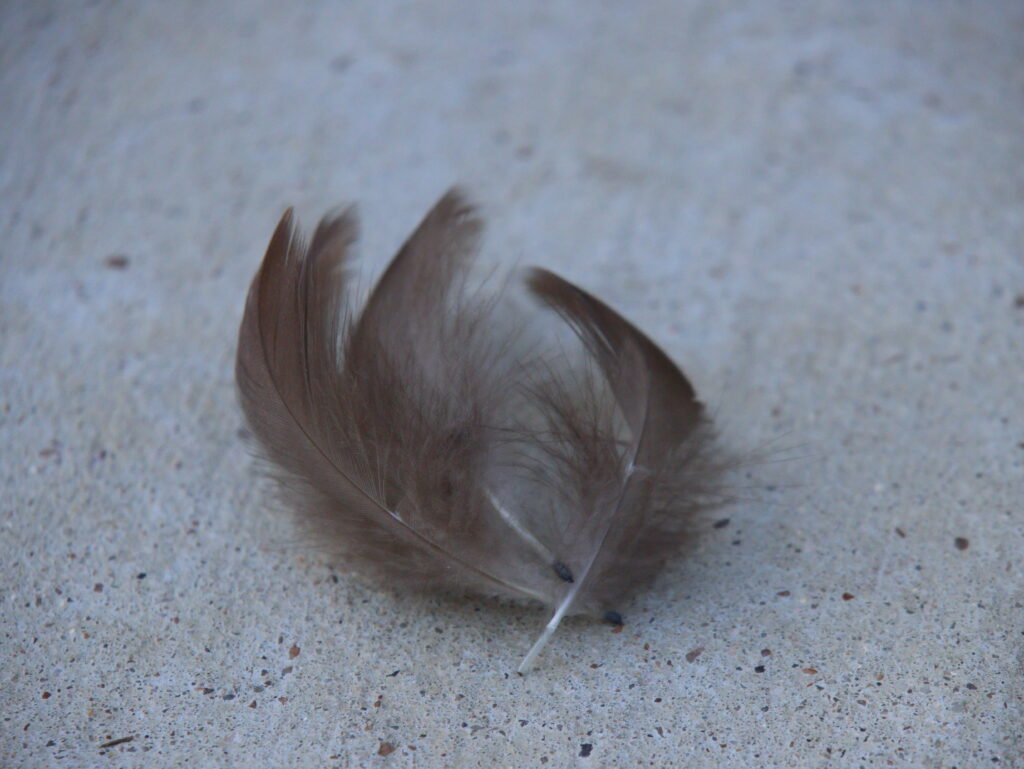
Flight (Remige) Feathers
Remiges are the longest, stiffest feathers on the wings (primaries and secondaries) and tail (rectrices), engineered for flight. Their asymmetric shape—narrower on the leading edge and broader on the trailing edge—optimizes lift and minimizes turbulence. During eclipse molt, ducks shed these feathers and become temporarily flightless until their replacements grow in, conserving energy when they’re most vulnerable.
Covert Feathers
Covert feathers form the smooth “skin” over a duck’s wings, hiding the bases of the long flight feathers and creating a sleek, aerodynamic surface. Arranged in three overlapping rows—lesser, median, and greater coverts—these feathers seal gaps between the primaries and secondaries, reducing drag as the duck glides or beats its wings.
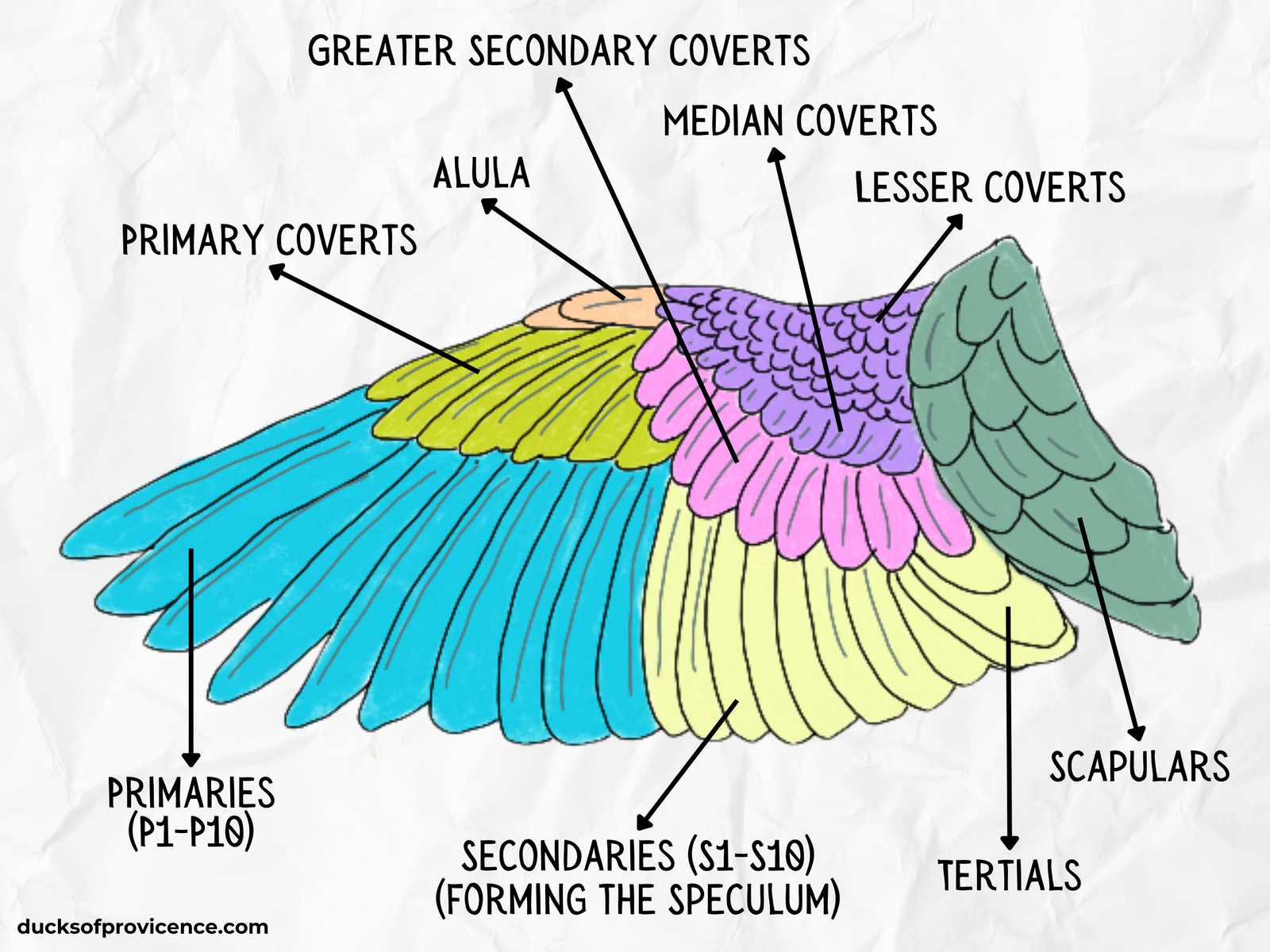
In many species, the median coverts include the brilliantly colored speculum, a patch of iridescent blues or greens that flashes in sunlight and plays a starring role in courtship and social signaling. Beneath their beauty, coverts also help lock in insulation and shed water: each feather interlocks with its neighbors and is regularly oiled during preening, forming an extra barrier against wind and spray.
By balancing streamlining, waterproofing, and visual communication, covert feathers showcase how every plume on your duck serves multiple, interwoven functions—truly a testament to evolutionary design.
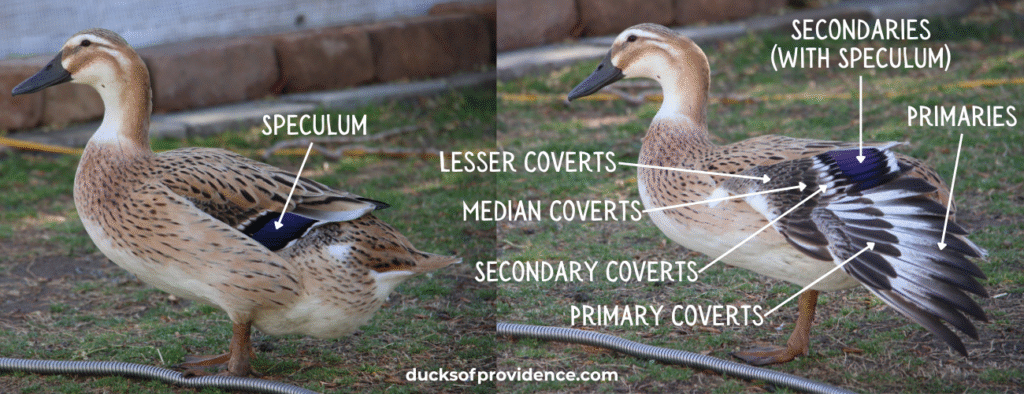
Semiplumes
Falling between down and contour feathers, semiplumes have a more pronounced rachis but loose, unhooked barbs. They insulate by filling gaps under the contour layer and help maintain a smooth body outline. When a duck puffs up, semiplumes swell and trap extra air, adding flexibility and warmth to the overall plumage.
Filoplumes
These hair-like feathers lie beneath the contour layer and consist of a thin rachis topped by a few barbs. Acting as sensory probes, filoplumes detect changes in feather position. Nerve endings at their base send feedback to the bird’s nervous system, allowing fine adjustments for optimal flight performance, insulation, and waterproofing.
Bristles
Found around the bill, eyes, and sometimes the lores, bristles are stiff, short feathers resembling long hairs. They shield sensitive areas from debris and water spray during foraging—think of them as a built-in dust mask and splash guard. In filter-feeding ducks, bristles can even help funnel tiny food particles toward the bill.
Curly Drake Feathers
Some male ducks (drakes) develop specialized curly tail feathers, often called “drake curls,” at the top of their tail. These small, S-shaped feathers curl upward and are seen in species like Mallards and certain domestic breeds. Though they don’t aid in flight or waterproofing, drake curls serve as visual signals of maturity and health, playing a role in mate attraction and species identification.

Duckling Feathers
When ducklings hatch, they’re first covered in a soft, downy coat called natal down. This fluffy layer isn’t yet the structured adult plumage you see later—it’s a fine network of unhooked barbs that trap warmth and protect delicate skin.
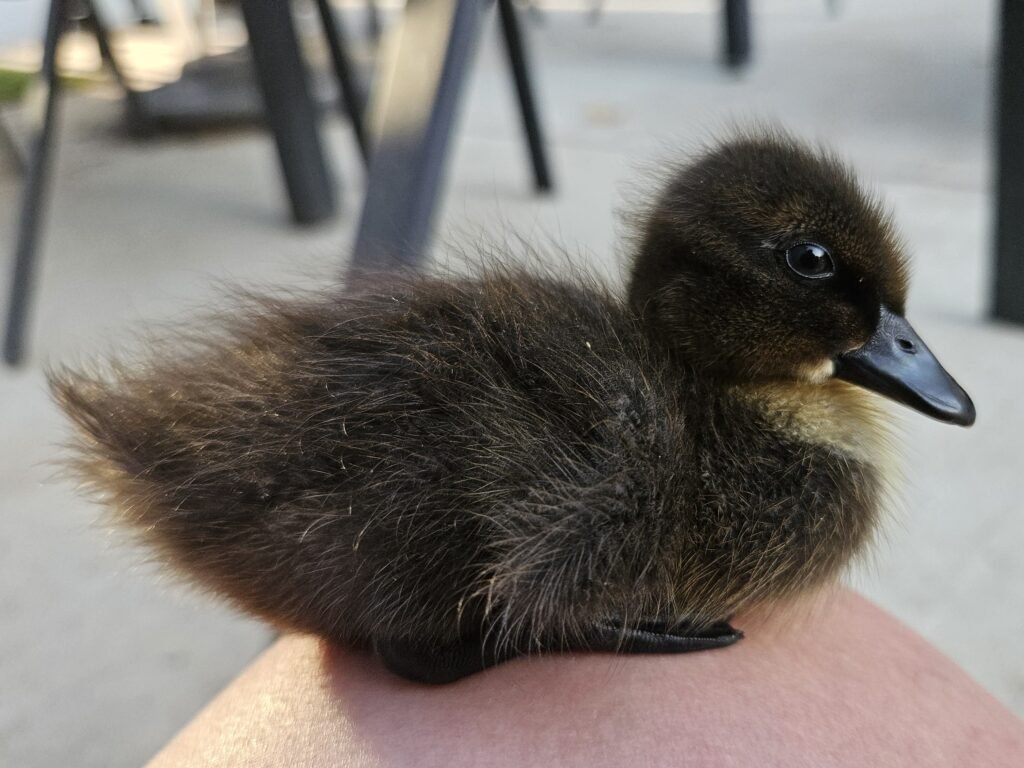
As the duckling grows, pin feathers (feathers in their sheath) begin to emerge. You’ll notice tiny, tube-like quills breaking through the down; these are the developing contour and flight feathers wrapped in a protective keratin covering. During this juvenile molt, the natal down falls away, and the young duck acquires its first set of true juvenile feathers—a blend of down and small contour feathers that looks a bit scruffy but provides both insulation and water resistance.
Key points about duckling feathers:
- Insulation: Natal down is exceptionally warm, allowing ducklings to regulate their temperature even before they can preen or swim confidently.
- Waterproofing Delay: Until they develop enough contour feathers and learn to preen, ducklings lack full waterproofing. That’s why many breeders keep them in shallow, supervised baths to prevent chilling.
- Color Changes: Juvenile plumage often shows muted, cryptic colors—browns, grays, or soft yellows—that help ducklings blend into grassy or reedy habitats and avoid predators.
- Transition to Adult Plumage: Over the first 8–12 weeks, ducklings undergo one or more molts: juvenile feathers give way to subadult, then adult plumage. The timing and number of molts depend on species and environmental factors like daylight and nutrition.
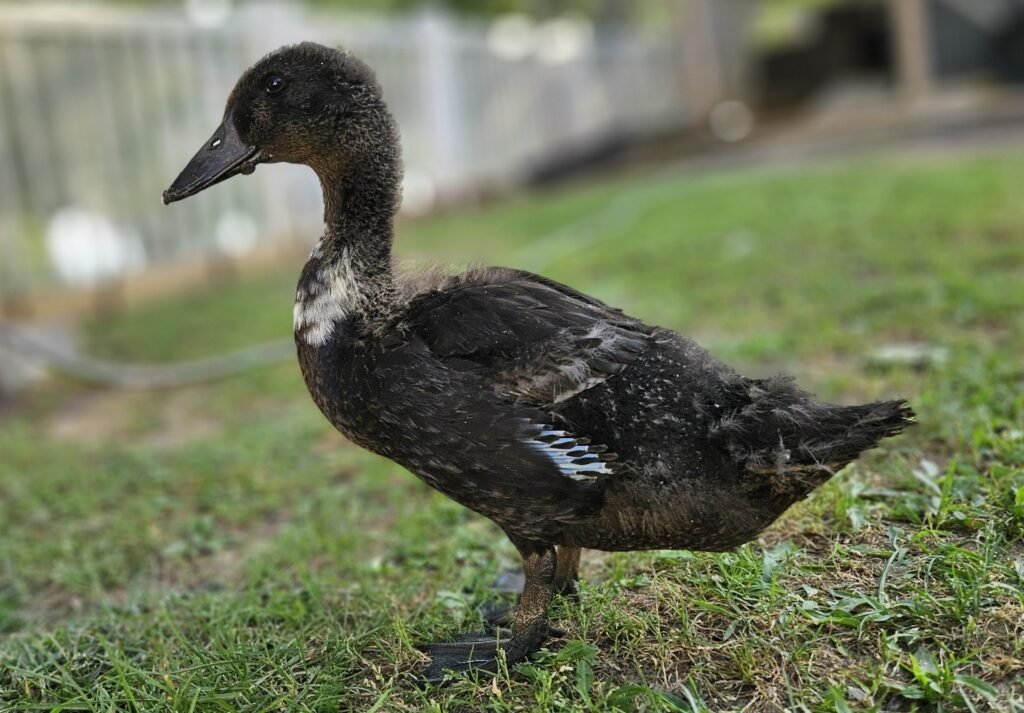
Understanding duckling feather development helps you provide proper care—offering dry, draft-free brooding areas, limited but safe water access, and high-quality protein in the diet to support healthy feather growth. Watching your chicks transform from a soft ball of fluff to sleek, water-ready juveniles is one of the most rewarding parts of duck keeping!
Functions of Feathers
Feathers aren’t just for show—they’re multifunctional marvels that help ducks fly, stay warm and dry, and even communicate. Below, we’ll dive deeper into the four primary roles feathers play in a duck’s daily life.
How Ducks Use Feathers to Fly:
When a duck soars into the sky, it relies on a precise arrangement of specialized feathers and subtle body adjustments to harness the forces of lift and thrust. The wing’s broad, arched shape comes from contour feathers that overlap smoothly, guiding airflow over and under the wing. Along the outer edge, the long, stiff primary flight feathers—anchored to the “hand” bones—provide powerful thrust with each downward and backward stroke. The slightly shorter secondary flight feathers, attached along the forearm, generate most of the lift by creating a curved airfoil profile.

As the wing moves, the curvature and angle of attack change dynamically: during the downstroke, primaries fan out to push more air backward, while secondaries lock together to maximize upward force. On the upstroke, the wing partially folds, reducing resistance as the feathers separate just enough to let air flow through. Meanwhile, coverts smooth the transition between body and wing, preventing turbulence and channeling air cleanly over the flight feathers.
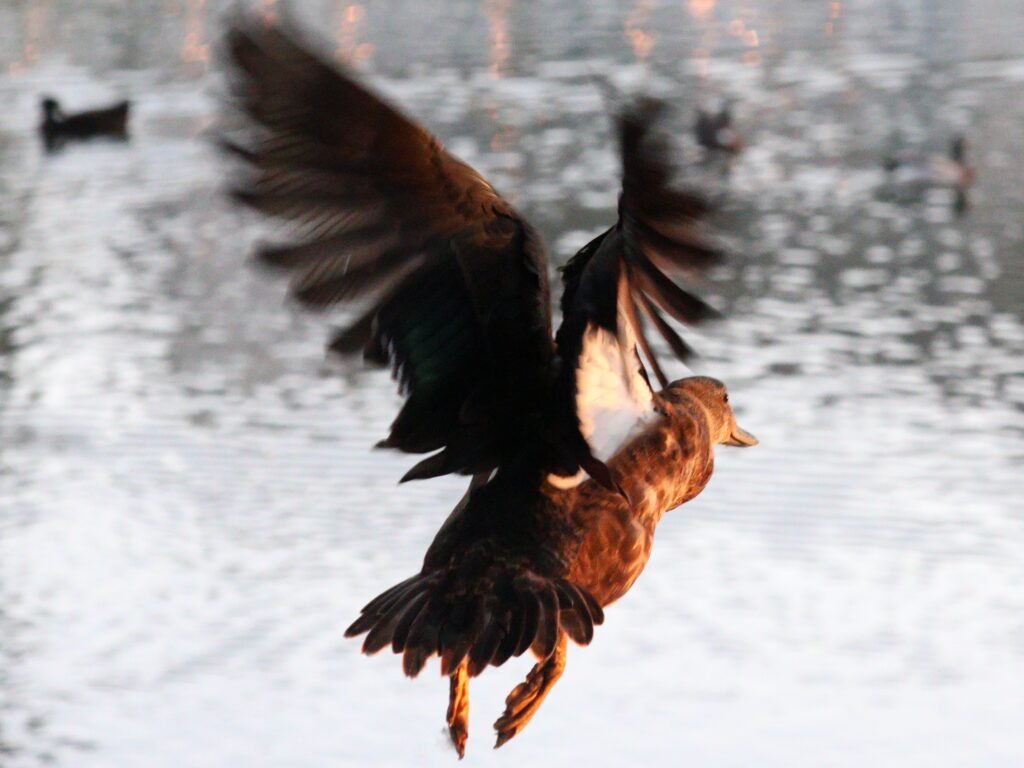
A duck’s powerful breast muscles control these feathered airfoils with remarkable precision, adjusting stroke angle, wing sweep, and tail feather position to brake, bank, or gain altitude. Even heavy-bodied breeds like the Pekin achieve surprisingly efficient flight by synchronizing muscle contractions with feather mechanics—turning each wingbeat into an elegant interplay of aerodynamics and anatomy.

How Duck Feathers Help With Insulation:
A duck’s down feathers form a plush, insulating layer closest to the skin. Each down plume is composed of countless soft, curly barbs that trap tiny pockets of air; this trapped air serves as a thermal buffer, keeping body heat from escaping into cold water or chilly air. Above the down lies the contour layer, which ducks can “zip” closed through careful preening—interlocking the barbs to seal out drafts much like zipping up a winter jacket. On crisp mornings, you might see your ducks fluffing their feathers: they subtly raise the outer layer and hunch their bodies, enlarging the trapped-air pocket and further enhancing warmth without expending extra energy.
Humans have long borrowed this same principle for our own cold-weather gear. Traditional down jackets, beloved for their exceptional warmth-to-weight ratio, harness clusters of goose or duck down in quilted compartments to mimic nature’s design. However, ethical concerns around live-plucking and the environmental footprint of feather harvesting have led most outerwear manufacturers to adopt synthetic insulation materials—such as polyester microfibers or eco-friendly PrimaLoft—which aim to replicate down’s loft and warmth without relying on animal products. While these man-made fills may not yet match down’s supreme compressibility or breathability, advances in fiber technology continue to narrow the gap, offering responsible alternatives that keep us warm without compromising animal welfare.
Waterproofing Duck Feathers:
A duck’s remarkable waterproofing system hinges on both feather structure and the ritual of preening. Each contour feather is lined with microscopic hook-and-groove barbules that interlock tightly, forming a dense, cohesive surface that prevents droplets of water from penetrating. But structure alone isn’t enough—ducks must actively reinforce this barrier every day. After swimming or bathing, you’ll see them meticulously preening: reaching their bill to the uropygial gland at the base of the tail, then drawing the clear, fatty oil through their beak and spreading it across every outer feather.
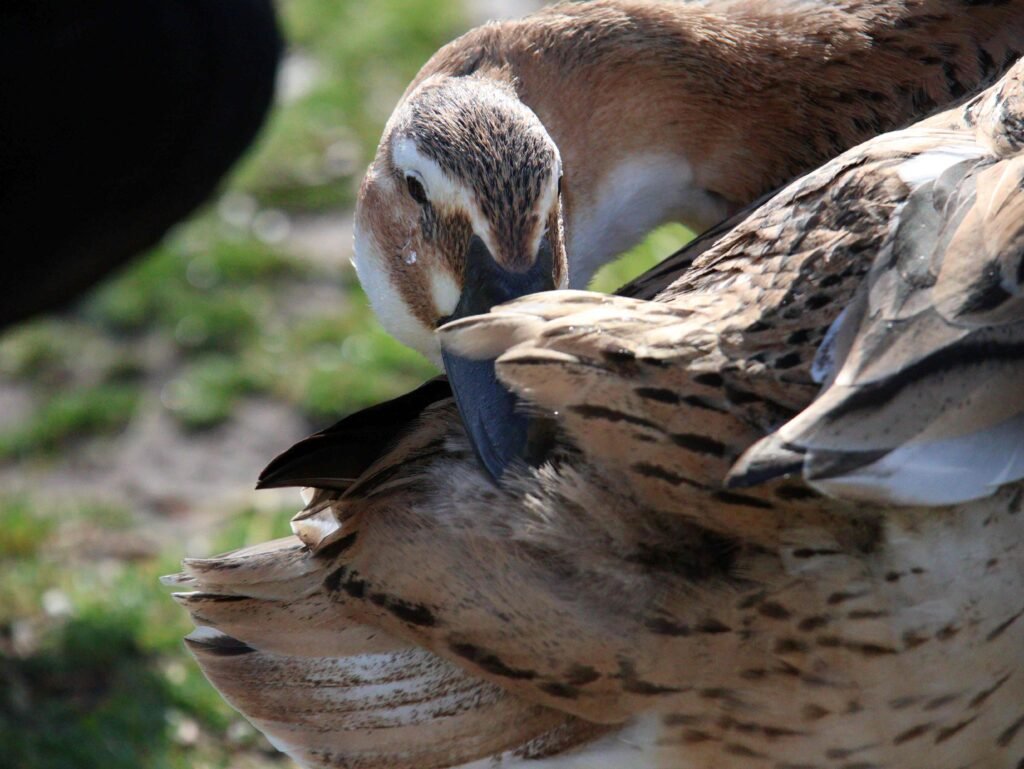
This preen oil serves multiple functions. Chemically, it fills tiny gaps between barbules, causing water to bead up and roll off, much like how rain skitters off a waxed car. The oil also keeps feathers supple, preventing them from becoming brittle and prone to breakage. By realigning and rehooking barbules during preening, ducks restore the tight “Velcro” seal that traps the insulating air layer beneath. Skipping or interrupting this grooming ritual can lead to matted, waterlogged feathers, compromised insulation, and even hypothermia in cold weather. In short, preening isn’t just a leisurely pastime—it’s a vital maintenance behavior that keeps ducks buoyant, warm, and ready for whatever the day brings.
Camouflage & Signaling:
Feather patterns serve as both invisibility cloaks and flashing billboards. Female ducks often display mottled browns, tans, and grays that mirror the reeds and grasses of nesting sites, rendering them nearly invisible to predators and prey alike. In contrast, males adorn themselves with bold, iridescent patches—like the metallic green sheen on a drake Mallard’s head—that shift color as the angle of light changes. These shimmering displays play a central role in courtship, signaling genetic fitness and attracting mates. Beyond romance, subtle shifts in feather posture—puffed-up chests or raised crests—can communicate aggression, submission, or alertness, allowing ducks to “speak” volumes without uttering a quack.
Duck Feather Maintenance
The Importance of Preening
Preening is the cornerstone of feather maintenance, a daily ritual in which ducks meticulously care for their plumage to preserve its waterproofing, insulation, and aerodynamic properties. You’ll often see a duck bending its neck, reaching its bill toward the base of the tail—that’s where the uropygial gland resides. This small gland secretes a clear, fatty oil that serves as the “feather conditioner” of the avian world.
With fine strokes of the bill, a duck draws this oil from the gland and then carefully works it through each feather’s shaft and vane. As it runs the beak along barbs and barbules, the duck realigns any misaligned barbules, “zipping” them back together so they interlock into a smooth surface. This interlocking action is what makes contour feathers shed water so effectively and traps insulating air beneath the outer layer.
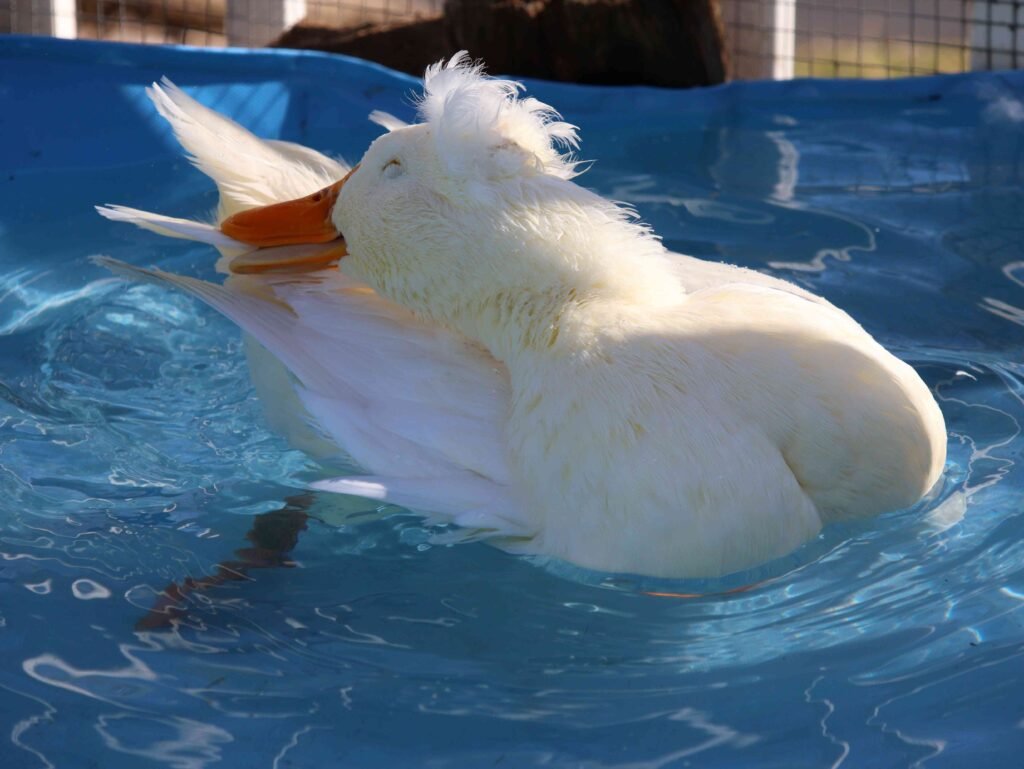
Preening also helps ducks remove dust, debris, and external parasites like lice or mites. Occasionally, you may notice a duck rubbing its head along its chest feathers—this head-scratching motion distributes oil to areas the bill can’t directly reach. In addition, ducks often engage in “anting,” where they allow ants to crawl over their feathers; formic acid secreted by the ants can help dislodge stubborn parasites.
Disruptions to preening—such as skin irritations near the uropygial gland, avian pox lesions on the bill, or restricted access to water—can lead to matted, waterlogged feathers that compromise insulation and buoyancy. If you observe dull, clumped plumage or a duck that avoids bathing, check for signs of gland swelling, injury, or illness. Ensuring your flock has clean water, a safe environment, and proper nutrition encourages thorough preening and keeps every feather in top condition.
Bathing
Bathing is more than just playtime for ducks—it’s a vital behavior that complements preening and keeps plumage in peak condition. By immersing themselves in water, ducks loosen dirt, dust, and debris that cling to their feathers. The gentle agitation of water also helps dislodge parasites like mites and lice before they can settle into the down and contour layers.

When ducks bathe, they often dunk their heads and bodies repeatedly, flapping their wings to work water through the feather canopy. This activity opens up the barbs and barbules, allowing water to reach the down layer. Immediately afterward, ducks will engage in an extended preening session to realign feathers and spread uropygial oil—restoring the waterproof seal and trapping a fresh layer of insulating air.
Practical Tips for Bathing Your Ducks:
- Provide Adequate Depth: Offer water deep enough for full-body submersion—typically 6–12 inches—so ducks can dip and flap comfortably. Shallow puddles or drinkers won’t give the same cleaning benefit.
- Keep It Clean: Change bathing water regularly—at least every 1–2 days—to prevent buildup of algae, droppings, or bacteria. A simple drain-and-refill routine preserves water quality without harsh chemicals.
- Supervise Ducklings: Young ducklings can tire quickly or chill if left too long in water. Provide a shallow “splash pool” and monitor them closely, ensuring they can easily climb out and warm up.
- Frequency Matters: In warm weather or after dusty foraging, daily access to a bath keeps feathers pristine. During colder months, offer baths less frequently (2–3 times per week) to avoid excessive chilling.
By combining regular bathing with thorough preening and high-quality water, you’ll help your flock maintain feathers that are clean, waterproof, and fully functional—ready for flying, swimming, and staying warm in any weather.
➡️ Learn more about the importance of water for ducks
Duck Molting
Molting is the natural process by which ducks replace old or damaged feathers with fresh growth, ensuring their plumage remains effective for flight, insulation, and waterproofing. Most ducks undergo a complete annual molt after the breeding season, typically in late summer. During this time, they shed and regrow all of their contour and flight feathers over the course of several weeks.
At the start of molt, you may notice small gaps or bare patches where feathers have fallen out. This can look alarming, but it’s a normal part of feather turnover. Ducks often time their molt to coincide with a period of abundant food and warmer weather, since growing new feathers demands extra protein and energy. In fact, many species—like mallards—enter an “eclipse” phase immediately following the breeding season. Males lose their bright breeding plumage and adopt a more camouflaged appearance as they grow new flight feathers; during this flightless window, they seek safe cover to avoid predators.
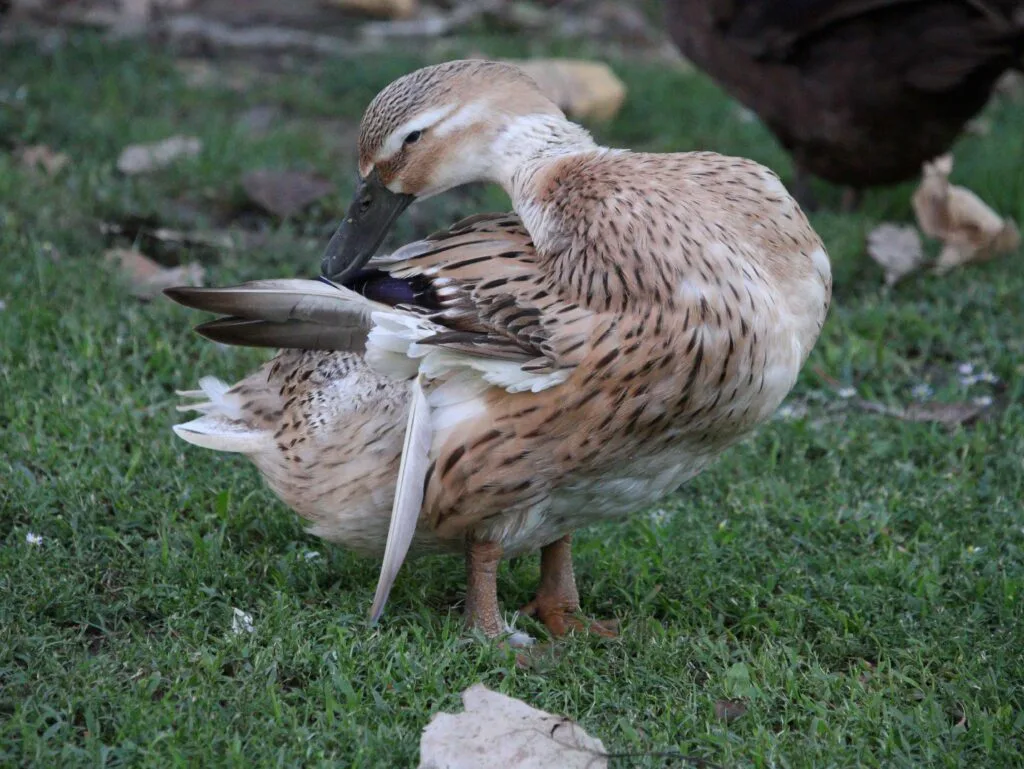
Juvenile ducks also molt, replacing their soft down and pin feathers with sturdy first-year contour and flight feathers. This juvenile molt generally occurs a few weeks after hatching and signals a transition toward independence. Throughout both juvenile and adult molts, providing high–protein feed (around 18–20% crude protein) and minimizing stress—by keeping water clean, avoiding excessive handling, and ensuring a quiet environment—helps ducks grow strong, resilient feathers.
Once molt is complete, you’ll see gleaming new feathers that lock together tightly, restore insulation, and bring back the lift and thrust needed for confident flight. Observing your flock through molt can deepen your appreciation for the energy and precision behind every feather.
➡️ Take a deeper dive into duck molting
How to Tell Something’s Off
Even the healthiest duck will occasionally show minor feather wear, but persistent or severe issues often signal underlying problems that deserve attention. Here’s what to watch for—and how to respond—when your duck’s plumage isn’t quite right.
Patchy or Missing Feathers
A few gaps in a molting duck can be normal, but large bare patches outside the expected molt period often point to trouble. Persistent bald spots may result from parasitic mites or lice burrowing at the feather base, tugging out plumes as they feed. In social flocks, overzealous preening or pecking by cage mates can also leave feathers missing. If you notice irregular bald areas, gently part the surrounding feathers to inspect the skin for tiny moving dots or scabs. Treat confirmed parasites with a vet-approved insecticide, and consider separating aggressive birds until wardrobes—and peace—are restored.
Broken or Frayed Barbs
When individual barbs appear snapped, splayed, or threadbare, look at your environment first. Sharp gravel or abrasive substrates underfoot can nick the edges of feathers as ducks shuffle or preen. Hard water with high mineral content can also weaken barbules, making them more prone to breakage when ruffled. Nutritional shortfalls—especially low dietary protein—compromise keratin synthesis, leaving feathers brittle. To prevent further damage, swap to a softer bedding material (pine shavings or planed lumber chips), install a water treatment that removes excess minerals, and ensure your feed contains at least 16–18% crude protein during feather-growing seasons.
Oily, Matted Feathers
A sheen of grease—or feathers stuck together in clumps—usually means preening isn’t happening effectively. Check that your ducks have easy access to a clean water source deep enough for full submersion; without adequate bathing, oil can build up rather than being worked into the plumage. Also examine the uropygial gland at the tail’s base—swelling, redness, or lack of secretions can indicate infection or inflammation. If the gland appears blocked or irritated, consult your avian vet. In the meantime, you may need to assist with gentle feather baths and light blow-drying to restore normal feather alignment.

Dull or Discolored Feathers
Healthy plumage should have vivid, consistent hues—be it the rich chestnut of a Cayuga or the gleaming green of a Mallard drake’s head. When feathers look washed-out, pale, or uneven, several factors may be at play:
Health Problems: Systemic issues—such as liver or kidney stress—can alter feather coloration and gloss. If dietary tweaks and environmental changes don’t improve feather brightness within a few weeks, arrange a veterinary exam to rule out metabolic or infectious causes.
Dietary Deficiencies: Carotenoid-dependent pigments fade if ducks lack those nutrients in their feed. Offer treats like leafy greens, carrots, or pumpkin to boost pigment intake and restore vibrancy.
Sun Bleaching: Prolonged exposure to intense sunlight can bleach feathers over time, especially if a duck hasn’t molted recently to renew its outer plumage. Providing shaded areas or encouraging more frequent molting by ensuring optimal nutrition can help prevent sun-induced fading.
Skin Irritation Beneath Feathers
Sometimes the feathers themselves appear fine, but the skin underneath betrays discomfort. Part feathers gently and look for redness, flaky scabs, or tiny black dots (mite droppings). These signs accompany dermatitis from bacterial or fungal infections, external parasites, or allergic reactions to bedding or cleaners. Affected areas may feel warm or tender to the touch. To soothe inflammation, isolate the bird in a clean, quiet space, switch to dust-free bedding, and apply topical antiseptics or antiparasitic treatments as recommended by a vet. Early intervention helps feathers regrow normally and prevents the issue from spreading through the flock.
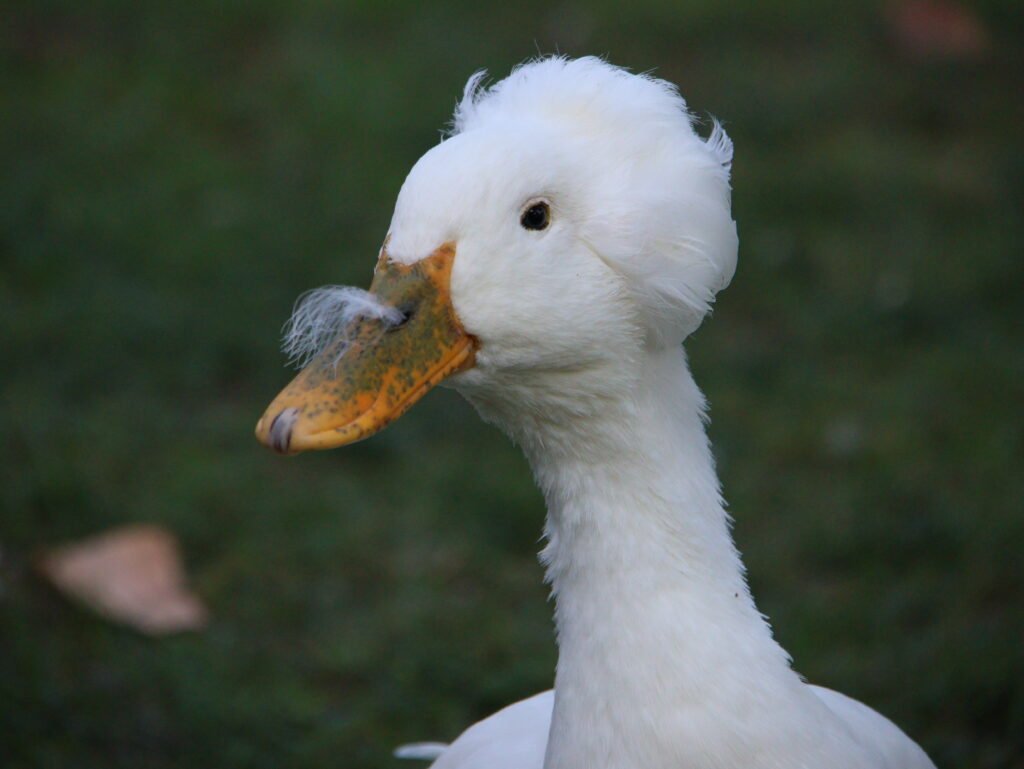
Wet-Feather Syndrome
If feathers remain waterlogged and fail to dry properly, the insulating air layer is lost and chilling can set in—even in mild weather. Wet-feather syndrome often indicates a breakdown in the waterproofing barrier: the barbule hooks may be damaged, or insufficient preening may have left oil coating uneven. You may notice a duck shaking more frequently, standing with feathers clamped close to the body, or lethargy after swimming. To help, provide supervised shallow baths so the bird can preen effectively afterward, and consider a gentle warm blow-dry if feathers don’t shed water naturally. Address any underlying issues—like oil gland problems or damaged plumage—so the duck can fully restore its water-repellent seal.
Bleeding Feathers
Occasionally you may find blood at the base of a developing feather, or notice a quill tip bleeding when a feather is shed or damaged. This bleeding feather, called a “blood feather,” still has a blood supply within its shaft and requires careful handling. If a blood feather is broken, the shaft can leak profusely. Apply gentle pressure with a clean cloth to stem bleeding, and use styptic powder or cornstarch to help clot. Never forcibly remove a bleeding feather; if it doesn’t stop bleeding after a few minutes of pressure, seek veterinary assistance to prevent anemia or infection. Once the feather heals and regrows normally, the risk of repeat bleeding diminishes.
By regularly observing your ducks’ plumage—and understanding what each warning sign means—you can catch problems early, provide targeted care, and keep your flock looking and feeling their best.
Final Thoughts
Feathers are far more than a duck’s wardrobe—they’re dynamic, multifunctional tools honed by evolution to keep your flock airborne, warm, dry, and socially connected. From the microscopic keratin networks that give strength and flexibility, to the iridescent nanostructures that dazzle potential mates, every plume tells a story of survival and communication. By observing your ducks’ preening rituals, molting cycles, and bathing behaviors, you’ll gain insight into their health and well-being—and catch problems before they become serious. Remember, a little extra attention to nutrition, water quality, and environmental enrichment goes a long way toward maintaining a vibrant, glossy coat.
Whether you’re marveling at the first downy fluff of a newly hatched duckling or admiring the curled tail feathers of a mature drake, feathers connect us to the remarkable biology of these birds—and to our own innovations in warmth and waterproofing. Keep learning, keep observing, and you’ll deepen both your care and your appreciation for one of nature’s most exquisite adaptations.
Related Articles
- Why Wet Feather in Ducks Happens and How to Fix It
- Navigating Pet Duck Molting: A Owner’s Handbook
- How to Conduct a Duck Health Check: A Comprehensive Guide
- Exploring Duck Migration
References
- Everything You Need To Know About Feathers: Cornell Lab: Bird Academy
- ASU Ask a Biologist: Feather Biology
- Hardy, John I., and Thora Marggraff Plitt Hardy. Feathers from domestic and wild fowl. Vol. 803. US Department of Agriculture, 1949.
- Arai, Kunio Murayama, et al. “The primary structure of feather keratins from duck (Anas platyrhynchos) and pigeon (Columba livia).” Biochimica Et Biophysica Acta (Bba)-protein Structure and Molecular Enzymology 873.1 (1986): 6-12.
- Mason, Clyde W. “Structural colors in feathers. I.” The Journal of physical chemistry 27.3 (2002): 201-251.
- Maia, Rafael, Liliana D’Alba, and Matthew D. Shawkey. “What makes a feather shine? A nanostructural basis for glossy black colours in feathers.” Proceedings of the Royal Society B: Biological Sciences 278.1714 (2011): 1973-1980.
- Eliason, Chad M., and Matthew D. Shawkey. “Rapid, reversible response of iridescent feather color to ambient humidity.” Optics Express 18.20 (2010): 21284-21292.
- Nordén, Klara Katarina, Chad M. Eliason, and Mary Caswell Stoddard. “Evolution of brilliant iridescent feather nanostructures.” Elife 10 (2021): e71179.


